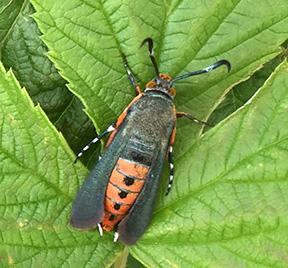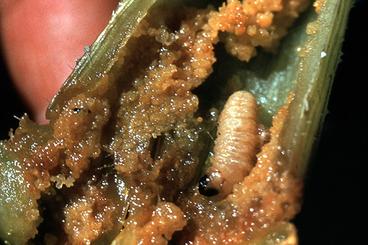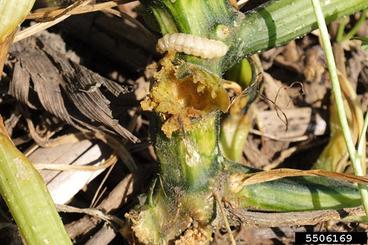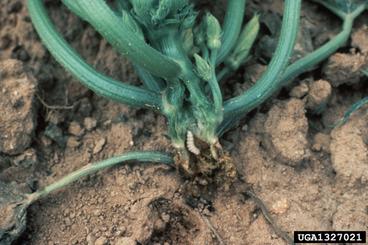E.C. Burkness and W.D. Hutchison
Department of Entomology, University of Minnesota
Introduction

The squash vine borer, Melittia cucurbitae, a clear-winged moth, is an occasional pest of vine crops in Minnesota. The preferred vine crops which squash vine borer attacks are winter squash, summer squash, and pumpkins. They attack cucumbers and melons less frequently. Unlike many moths, they are fast, noisy daytime flyers that are sometimes mistaken for wasps. The larvae cause plant damage by feeding within the stem, which results in wilting. Sometimes, the feeding damage is so pervasive that the entire plant collapses.
Biology & Life Cycle
Squash vine borers have stout bodies about ½ inch in length with a wingspan from 1 ¼ to 1-½ inches. The adult body is reddish with black bands encircling the abdomen. The front wings are a metallic green. The hind wings are clear with dark veins and fringed with reddish brown hairs. The larvae are white to cream-colored caterpillars with brown heads which grow to about one inch in length.
The adults emerge from mid-June through July from cocoons in the soil. They typically lay their small (1/25"), oval, brown eggs singly on stems or leaf stalks towards the base of the plant. Eggs hatch in 7-10 days. Upon hatching, the larvae immediately bore into the stem, leaving large entrance holes and yellowish frass. After feeding for about a month, the borers exit from the stem and burrow into the soil. They overwinter in a cocoon and pupate in the spring. There is one generation per year in the upper Midwest.


Damage

Larvae damage plants by severing the water and nutrient conducting tissue. As a result, the plants start to wilt. Other pests also cause wilting symptoms such as the squash bug, aphids, or bacterial wilt which is vectored by the striped cucumber beetle. In order to determine if the squash vine borer is causing the wilting, look for large holes, typically at the base of the stem, and large amounts of yellowish-green frass extruding from the holes. If these symptoms exist, split the stems apart with a sharp knife to look for the larvae. If several larvae have infected a plant, the plant may collapse and die.
Management
Most management options are limited to controlling the hatching larvae (first instars) before they enter the plant. Once the larvae invade the stem, little can be done except to scrape the larvae out of the stem and cover the stem with dirt to promote possible growth of new roots. If the main root and stem are injured, this tactic may allow the plant to recover and continue to grow. Growers and gardeners, however, can be more proactive by looking for the adult moth flying around their plants from mid-June through July. Growers can also monitor moth presence by placing pheromone traps near squash or pumpkins. Pheromone traps and lures (EZA 2,13/ZZA 99:1 or blend) attract male moths, and are available from several commercial suppliers (see list below). Since the pheromone may attract a variety of clearwing borer moths, identification and knowledge of clearwing borer moths will be necessary. The home gardener may put out large yellow pails filled with water. The moths are attracted to yellow and are trapped when they fall into the water.
Cultural Control
If a field has had a borer infestation, destroy infected crops and avoid planting cucurbits in the same area the following year. Disking the soil in early fall should expose cocoons that are buried 1-6 inches deep.
Resistant Varieties. Butternut squash exhibits a higher level of resistance than Hubbard and Acorn squashes, which are highly susceptible to borer damage.
Mechanical Control. Floating row covers placed over the crops prevent the moths from laying eggs. Place the floating row covers over the plants as they start to vine or when you notice any squash vine borers in the area. Firmly anchor the row covers to the ground or the moths will crawl under it. In addition, remove row covers during flowering to permit maximum pollination.
Monitoring & Chemical control
There are no threshold guidelines regarding how many frass damaged plants or how many captured adult moths indicate a need for chemical control. The most practical way to prevent widespread damage is to detect the earliest signs of adult and/or egg-laying activity, as well as larval damage before the remaining eggs have hatched. A spray is most effective just as the larvae are hatching from their eggs and before they burrow into the stem. To ensure proper use of insecticides, also refer to the most recent edition of the Midwest Vegetable Production Guide. Spray or dust the stems and vines at the base of the plant once or twice 7-10 days apart.
The available forms of Bacillus thuringiensis (Bt) formulations are not effective against this pest; it is difficult to spray the internal parts of the stems where the larvae are eating. Since insecticides such as carbaryl may kill bees, avoid spraying during flowering. If sprays are necessary during flowering, spray very early in the morning or in the evening when the bees are less likely to be active in the field or garden.
Pheromone Trap Suppliers
Traps and pheromones are available from some of the following suppliers. Reference to specific companies or products is not intended to be an endorsement to the exclusion of others, which may have similar uses.
Gempler's Pest Management Supply
P.O. Box 270
Mt. Horeb, WI 53572
Tel: 1-800-382-8473 Fax: 1-800-551-1128
https://www.gemplers.com
Great Lakes IPM
10220 Church Rd. NE
Vistaburg, MI 48891-9746
Tel: 517-268-5693 or 517-268-5911 Fax: 517- 268-5311
http:///www.greatlakesipm.com
Trece, Inc.
P.O. Box 6278
Salinas, CA 93912 Tel: 831-758-0204 Fax: 831-758-2625
http://www.trece.com/
References
Cornell University. 2003. Vegetable Disease ID and Management http://vegetablemdonline.ppath.cornell.edu/
Fleischer, S. 2001. The Squash Vine Borer. https://ento.psu.edu/extension/factsheets/squash-vine-borer
Foster R. & B. Flood. 1995. Vegetable Insect Management. Meister Publishing Co. Willoughby, Ohio.
Hahn, J. 1999. Yard & Garden Brief: Squash Vine Borer Management in Home Gardens. http://www.extension.umn.edu/garden/insects/find/squash-vine-borers/
Metcalf, R.L. & R.A. Metcalf. 1993. Destructive and Useful Insects. 5th Edition. Insects Injurious to Cucurbits. McGraw-Hill, Inc. New York. Taft, W. and J. Snow. 1991.
Purdue University. Midwest Vegetable Production Guide for Commercial Growers; https://mwveguide.org/
Taft, W. and J. Snow. 1991. A Guide to the Clearwing Borers (Sisiidae) of the North Central United States. North Central Regional Publication No. 394. C. Welty.
Squash Vine Borer-Ohio State University Extension Fact Sheet.
Zandstra, B.H., E.J. Grafius, C. T. Stephens. 1986. Extension Bulletin E-1953. Michigan State University Cooperative Extension Service.
Zitter, T.A. D.L. Hopkins, C.E. Thomas. 1996. Compendium of Cucurbit Diseases. APS Press. St. Paul, MN. pp. 71-72.